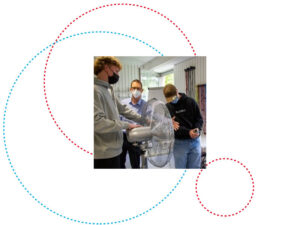Students from the Lycée Michel Lucius participated in the energy balance workshop conceived by physicists and computer scientists from the University of Luxembourg. By doing experiments with renewable energies, secondary school students could understand the difference between energy and power, measure their current energy footprint and find possible ways of improvements.
Measuring energy footprint
A person’s energy footprint is the energy that is consumed in order that the person may live in the way that they are accustomed to. It is determined by asking someone to indicate its habits (housing, diet, daily transportation, vacations, etc). The collection of facts, along with scientific-based data, makes it possible to calculate the total amount of energy required by the person. If you would like to calculate your own energy footprint, please go to https://e4l.uni.lu
“However, calculating the energy footprint is only one part of the problem, as it is still difficult to understand if such a footprint is small or big, whether it is below or above average, and perhaps more importantly, if it is possible to generate that energy 100% renewably in Luxembourg. Since the aim of the EU is to go net zero carbon emissions by 2050, then we should find a way to cover our energy footprint only using renewable energy technologies”, explains Prof. Phillip Dale, Head of the Laboratory for Energy Materials at the University of Luxembourg.
“Another problem we encountered is that we don’t really have a good feeling for what is meant by energy or power, since most of the time they are invisible. We only know something about them when the building’s electricity or heating is turned off. Even worse, we have no idea for quantities of energy. For example, a person’s daily energy consumption is 150 kWh per day. What does that mean? How can we picture this amount of energy? Faced with these problems we conceived the Energy Balance workshop to overcome them”, continues Phil.
Energy Balance workshop
The workshop, primarily designed for secondary school students, aims to make young people understand the difference between energy and power, measure their energy footprint, and whether this consumption can be met by renewable technologies in Luxembourg, or if it is impossible. To do this, they experiment with actual renewable technologies, namely photovoltaics, wind, biomass and human bike energy, to see how much energy can be generated per square meter.
“The human bike is particularly revealing since participants can directly feel the power that they generate, and the limitations of the human body. It reveals the intermittency of energy supply and how lucky we are to have electricity flowing from the electrical socket 24 hours a day. At the other stations they see how much energy can be generated at the classroom level. From there, they can calculate how much land area they need to support their energy footprint and eventually scale the result for Luxembourg’s population”, says Michele Melchiorre, research scientist within the University of Luxembourg.
“By comparing the energy need and the area that is required to generate that energy, students can get an understanding if it is possible to go 100% renewable or not. This also leads to the realisation that the amount of land area required for energy generation is directly linked to our energy habits. For example, choosing to take the car or the train directly changes the amount of energy we need to generate, and hence also the amount of land and equipment required”, comments Michele.
Energy balance project
The workshop is part of the Energy balance project funded by the Luxembourg National Research Fund (FNR) in the frame of the “Promoting Science to the Public” (PSP-Classic) programme. Researchers in physics (Phillip Dale, Michele Melchiorre, Conrad Spindler), computer scientist (Alfredo Capozucca) and learning scientist (Robert Reuter) have been working together to create an IT-based solution to help people calculate their energy footprint.
This solution has been materialised as a web application that supports the delivery of the workshop which enables each student to measure his/her energy footprint, and to know where he/she stands among the other students participating in the workshop. Moreover, the application also allows the student to know how much land area would be needed to go 100% renewable if everyone in Luxembourg lives like him/her.
With the help of the Scienteens Lab, 346 secondary school students have participated in the workshop. The project has now come to an end, but there is sufficient interest from the schools that we carry it on. Therefore, we created a smaller version of the workshop for the Science festival 2021 and have offered school teachers five dates per year where we will repeat the full version.
“I would like to thank all the persons and volunteers who were involved in this project, it has been a real team effort”, concludes Phil Dale.
More information: https://e4l.uni.lu
